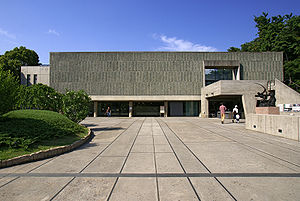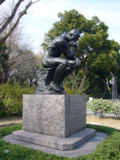
Matsukata Kojiro
Encyclopedia

was an early 20th-century businessman who devoted his life and fortune to amassing a collection of Western art which, he hoped, would become the nucleus of a Japanese national museum focused particularly on masterworks of the Western art tradition. Although his plans were not realized in his lifetime, his vision is commemorated in Japan's National Museum of Western Art (NMWA) in Ueno, central Tokyo.

Background


Meiji period
The , also known as the Meiji era, is a Japanese era which extended from September 1868 through July 1912. This period represents the first half of the Empire of Japan.- Meiji Restoration and the emperor :...
Finance Minister
Minister of Finance (Japan)
The is the member of the Cabinet of Japan in charge of the Ministry of Finance. This position was formerly cited as being Japan's most powerful and one of the world's, because Japan had historically held the largest foreign exchange reserves...
and genrō
Genro
was an unofficial designation given to certain retired elder Japanese statesmen, considered the "founding fathers" of modern Japan, who served as informal extraconstitutional advisors to the emperor, during the Meiji, Taishō and early Shōwa periods in Japanese history.The institution of genrō...
, Matsukata Masayoshi
Matsukata Masayoshi
Prince was a Japanese politician and the 4th and 6th Prime Minister of Japan.-Early life:...
. After being educated in the United States at Rutgers Preparatory School
Rutgers Preparatory School
Rutgers Preparatory School is a private, coeducational, university preparatory day school located in Somerset, New Jersey serving students in Pre-Kindergarten through 12th grade...
, an elite college preparatory school in New Jersey
New Jersey
New Jersey is a state in the Northeastern and Middle Atlantic regions of the United States. , its population was 8,791,894. It is bordered on the north and east by the state of New York, on the southeast and south by the Atlantic Ocean, on the west by Pennsylvania and on the southwest by Delaware...
, he became president of Kawasaki Shipbuilding Company
Kawasaki Shozo
was a Japanese industrialist, and shipbuilder. He founded Kawasaki Heavy Industries, Ltd..- Overview :Born in Kagoshima to a kimono merchant, Kawasaki Shōzō became a tradesman at the age of 17 in Nagasaki, the only place in Japan then open to the West. He started a shipping business in Osaka at...
(Kawasaki Shōzō) in 1896 and then went on to become head of Kowasaki Dockyards from 1916 through 1923.
The financial success he enjoyed in the early part of the century was affected adversely by economic downturns in the 1920s and 1930s; but much of his art collection remained intact despite the collapse of his business interests.
Art collecting
Masukata invested his significant personal fortune in the acquisition of several thousand examples of Western painting, sculpture and decorative arts. He collected these art works throughout Europe, but primarily in Paris. Mutsukata bought the Rodin masterpiece, "Gates of Hell," which is currently to be seen at the Rodin Museum in Paris; and the sculptures on display in the NMWA entrance plaza were made from the same original molds. In the end, he hoped to see his collections in an art museum in Tokyo where visitors could come into direct contact with Western art; and he wanted the people of Tokyo to enjoy the same degree of easy access to great art which was available to Parisians.Matsukata is also famous for his collection of ukiyo-e
Ukiyo-e
' is a genre of Japanese woodblock prints and paintings produced between the 17th and the 20th centuries, featuring motifs of landscapes, tales from history, the theatre, and pleasure quarters...
woodblock prints which had been scattered throughout the world. The 1925 exhibition of the woodblock prints Mtsukata collected abroad is thought to have been the first of its kind in Japan. Today approximately 8,000 ukiyo-e prints from the Matsukata collection are housed in the Tokyo National Museum.
Among these works collected by Matsukata, those known today as the NMWA Matsukata Collection remained in France after World War II; and as part of the San Francisco Peace Treaty, they were briefly confiscated by France. Although most were sent to Japan, 14 valuable paintings by Monet, Van Gogh, Courbet, Cézanne, and others were retained to fill in gaps in the French national collection. The remaining objects in the Matsukata collection totaled 370 works, including 196 paintings, 80 drawings, 26 prints and 63 sculptures -- including massive public statuary by Rodin which now grace the landscaped area in front of the entrance to NMWA. Each of the Rodin sculptures in the NMWA collection were cast from the original molds. In fact, as it happens, Matsukata was the one who paid for the best Rodin castings in France today, but he didn't quite manage to bring them back to Japan, which is how they fell into French hands at the end of World War II. The Matsukata Collection is in Tokyo today because France eventually gave these artworks to the Japanese people.
Matsukata was well-known as a good friend of Claude Monet. It has been reported that once, when Monet offered him the opportunity to buy whatever he wanted in the studio at Giverny, he purchased 18 paintings. His other artist friends included Frank Brangwyn
Frank Brangwyn
Sir Frank William Brangwyn RA RWS RBA was an Anglo-Welsh artist, painter, water colourist, virtuoso engraver and illustrator, and progressive designer.- Biography :...
, who assisted Matsukata in the acquisition of his collection. Brangwyn designed a gallery, the so-called Palace of Sheer Pleasure, which Matsukata intended to build in Tokyo.
He had originally intended to bring all these artworks to Japan, but he balked at the 100% tax imposed on imports. Much of what was stored in Britain was destroyed by fires during World War II; and much of what remained in Japan was also destroyed by Allied bombing during the Pacific War. The combination of factors which kept so much of his collecting activities intact was only seen by the Japanese public for the first time in 1959 when they visited the museum he had envisaged.

